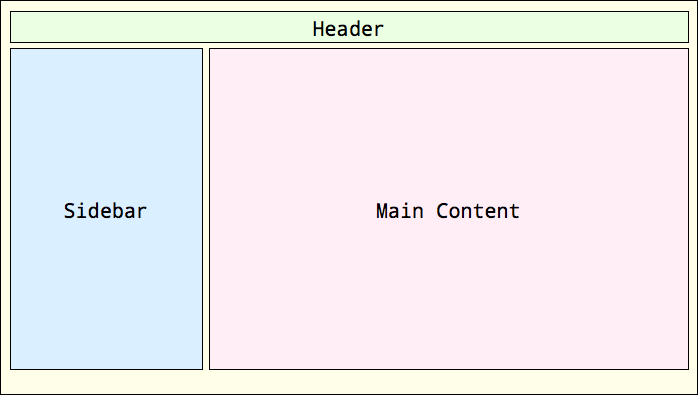The basics of using ui-router with AngularJS
edit ✏️URL routing is a popular approach to matching the contents of a URL to specific functionality within a web application. URL routes programatically present specific content to users based on the URL that they are visiting. It is a popular approach that has proven to be very effective.
Something that might not be obvious is that URL routing is also a finite state machine. When you configure the routing for an app, you are laying out the various states the application can be in, and informing the application what to display and do when a specific route is encountered.
AngularJS supplies URL routing by default. It is adequate, but also has some limitations.

So what's the problem?
Looking at the structure above, imagine an application where interacting with
items on the header or the sidebar causes the main content to load completely
different HTML. AngularJS provides a mechanism for this with ng-switch. You
can see a (very simple) example of this below.
In this case, ng-switch is swapping out div elements, but you can also use
this approach to swap out templates using ng-include.
I'm not going to explore this option. I'm not particularly fond of it.
Why not?
- The
ng-switchadds markup that could be confusing - The state of the main content area is captured and stored on a model
- It feels like "logic in markup", which I try to avoid
- If you go down the
ng-includeroad, you need to remember to always put single quotes around your template names. I always forget. ;<
ui-router
ui-router fully embraces the state-machine nature of a routing system. It allows you to define states, and transition your application to those states. The real win is that it allows you to decouple nested states, and do some very complicated layouts in an elegant way.
You need to think about your routing a bit differently, but once you get your head around the state-based approach, I think you will like it.
This example is functionally very similar to the ng-switch approach. The main
difference is that the main content area is populated with templated HTML for
each of the states, without using switching or ng-include.
angular.module('app', ['ui.compat']).config([
'$stateProvider',
function($stateProvider) {
var home = {
name: 'home',
url: '/',
templateUrl: 'content.html',
},
red = {
name: 'red',
url: '/red',
parent: home,
templateUrl: 'content.red.html',
},
blue = {
name: 'blue',
url: '/blue',
parent: home,
templateUrl: 'content.blue.html',
},
green = {
name: 'green',
url: '/green',
parent: home,
templateUrl: 'content.green.html',
};
$stateProvider.state(home);
$stateProvider.state(red);
$stateProvider.state(green);
$stateProvider.state(blue);
},
]);The above code is the configuration for the router. We are defining the module, but instead
of injecting $routeProvider as we would with stock AngularJS, we are injecting
a $stateProvider that is used to define the states. We are defining 4 states.
homeis the parent state of the next 3. It defines the header, siderbar, and theui-viewelement that will be populated with the child states.redis the first child state. It references thehomeas its parent, as well as targeting its own template.blueandgreenare identical tored, but use different templates.
After the states are defined, they are added to the $stateProvider. They are
now ready to be navigated to.
.run(['$state', function ($state) {
$state.transitionTo('home');
}])the run method is a great place to navigate to your intial state. You are able to
inject the now-resolved $state object and use its transitionTo method to set home
as the current state.
.controller('SidebarCtrl', function ($scope, $state) {
$scope.content = ['red', 'green', 'blue'];
$scope.setPage = function (page) {
$state.transitionTo(page);
};The SidebarCtrl lists contains a simple array called content on its $scope which
is used in a ng-repeat to give us a simple menu. When one of those items is clicked
the setPage function is called with the item that was clicked. In this case, the
content items correspond to the names of the states that we've defined, so we simply
transitionTo the selected state to display the content of that state.
Next steps with ui-router
This only really scratches the very surface of what you can pull off with ui-router. There are a ton of options and the wiki is well put together. Some things I didn't explore, but that are available:
- Passing data between states
- Listening for state events
- Named views (love this, it deserves its own post)
- URL Routing
The ui-router README warns that the utility is still in active early development. The API is still subject to change, so if you choose ui-router for your next project, that is something to be aware of.
Let me know if you'd like me to explore ui-router a bit deeper in future posts. I think it is an excellent approach to routing, and look forward to using it more.
Update: I've recorded a screencast about ui-router for egghead.io.
Update 2: Here's a screencast about ui-router's named views that I recorded for egghead.io. (note: it is paid/subscription content)